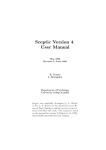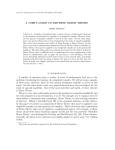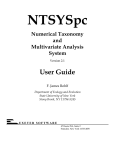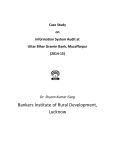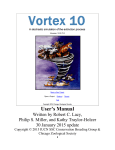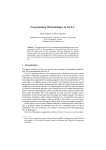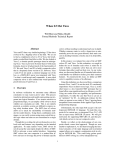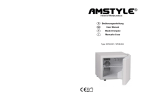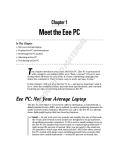Download Sceptic User Manual
Transcript
Sceptic User Manual
September 1989, revised March 1990
Version 3.0, December 1990
Saki Hajnal
John Fox
Paul Krause
Advanced Computation Laboratory
Imperial Cancer Research Fund
61 Lincoln's Inn Fields
London
WC2A 3PX
Contents
1 Introduction
2 Syntax
3 Using Sceptic
3.1
3.2
3.3
3.4
3.5
Starting the system . . . . . .
Loading a le of productions
Escaping to Prolog . . . . . .
Typing in extra productions .
Conguring the system . . . .
.
.
.
.
.
.
.
.
.
.
.
.
.
.
.
.
.
.
.
.
.
.
.
.
.
.
.
.
.
.
.
.
.
.
.
.
.
.
.
.
.
.
.
.
.
.
.
.
.
.
.
.
.
.
.
.
.
.
.
.
.
.
.
.
.
.
.
.
.
.
.
.
.
.
.
.
.
.
.
.
.
.
.
.
.
.
.
.
.
.
.
.
.
.
.
.
.
.
.
.
.
.
.
.
.
.
.
.
.
.
.
.
.
.
.
.
.
.
.
.
.
.
.
.
.
.
.
.
.
.
.
.
.
.
.
.
.
.
.
.
.
.
.
.
.
4 Execution
1
3
4
4
4
5
5
6
8
4.1 The cycle . . . . . . . . . . . . . . . . . . . . . . . . . . . . . . . . . . . . . . . . 8
4.2 End-of-cycle processing . . . . . . . . . . . . . . . . . . . . . . . . . . . . . . . . 8
4.3 Triggers . . . . . . . . . . . . . . . . . . . . . . . . . . . . . . . . . . . . . . . . . 9
5 Relation to Prolog
10
5.1 Internal form . . . . . . . . . . . . . . . . . . . . . . . . . . . . . . . . . . . . . . 10
5.2 Calling Prolog from Sceptic . . . . . . . . . . . . . . . . . . . . . . . . . . . . . . 10
5.3 Calling Sceptic from Prolog . . . . . . . . . . . . . . . . . . . . . . . . . . . . . . 10
6 Debugging
6.1
6.2
6.3
6.4
The Sceptic debugger . .
Initial command settings .
Act phase commands . . .
Rec phase commands . . .
.
.
.
.
.
.
.
.
.
.
.
.
.
.
.
.
.
.
.
.
.
.
.
.
.
.
.
.
.
.
.
.
.
.
.
.
.
.
.
.
.
.
.
.
.
.
.
.
.
.
.
.
.
.
.
.
.
.
.
.
.
.
.
.
.
.
.
.
.
.
.
.
.
.
.
.
.
.
.
.
.
.
.
.
.
.
.
.
.
.
.
.
.
.
.
.
.
.
.
.
.
.
.
.
.
.
.
.
.
.
.
.
Robustness . . . . . . . . . . . . .
Eciency . . . . . . . . . . . . . .
Why not just use Prolog? . . . . .
Is Sceptic a specication language?
.
.
.
.
.
.
.
.
.
.
.
.
.
.
.
.
.
.
.
.
.
.
.
.
.
.
.
.
.
.
.
.
.
.
.
.
.
.
.
.
.
.
.
.
.
.
.
.
.
.
.
.
.
.
.
.
.
.
.
.
.
.
.
.
.
.
.
.
.
.
.
.
.
.
.
.
.
.
.
.
.
.
.
.
.
.
.
.
.
.
.
.
.
.
.
.
.
.
.
.
.
.
.
.
7 Caveats
7.1
7.2
7.3
7.4
8
A
B
C
.
.
.
.
.
.
.
.
.
.
.
.
Pitfalls for the Unwary
Truth Maintenance Example
Pursuer-Evader Example
Command Summary
12
12
12
13
14
16
16
16
16
16
17
19
25
33
C.1 Top level commands . . . . . . . . . . . . . . . . . . . . . . . . . . . . . . . . . . 33
C.2 Conguration parameters (normally in sceptic.ini) . . . . . . . . . . . . . . . . . 33
C.3 Debugging commands . . . . . . . . . . . . . . . . . . . . . . . . . . . . . . . . . 33
D Backwards Compatibility
35
D.1 Old functionality (now removed) . . . . . . . . . . . . . . . . . . . . . . . . . . . 35
D.2 New functionality (not present in previous releases) . . . . . . . . . . . . . . . . . 36
ii
E Prolog-specic Issues and Portability
37
E.1 Prolog portability . . . . . . . . . . . . . . . . . . . . . . . . . . . . . . . . . . . . 37
E.2 Application portability . . . . . . . . . . . . . . . . . . . . . . . . . . . . . . . . . 37
iii
1 Introduction
Sceptic draws upon experience using Prolog and Props2, the latter a language developed at
icrf which combined some features of a logic programming language with others more typical
of production-rule interpreters.
Prolog is a practical AI programming language, but its roots lie in formal logic, theorem proving and databases. One of the main reasons for developing Props2 was the perception that
a language for building intelligent automata should also support opportunistic computation
(computation in response to events occurring unpredictably in time). Prolog applications can
be programmed to have this characteristic (indeed Props2 is written in Prolog) but Prolog's design emphasises formal logical properties above any other properties considered to be desirable
for autonomous systems.
Production systems, which have been widely used for modelling human cognition, emphasise
event-oriented rather than state-oriented computations. Like Prolog, however, production systems have to compromise with the requirements of practical programming. OPS5, for example,
has acquired many features and data structures during its development which have obscured
its underlying computational model, made it a somewhat dicult language to use and its applications dicult to maintain. Consequently, since Props2 was also intended as a serious
engineering tool, a second aspect of its design was the preservation of a sound, declarative style
of programming.
Props2's emphasis on data-driven computation was supported by a truth-maintenance system,
a default mechanism, and a number of experimental mechanisms for logical reasoning about
control. However the specic form of these features was not appropriate for all applications.
Sceptic has been designed to support a data driven style of computation, but without imposing any constraints on the exact truth maintenance and default mechanisms which may be
implemented.
Sceptic interprets a production syntax and executes productions in a forward or data-driven
control cycle. Sceptic is currently implemented in Prolog, and provides full access to the
underlying Prolog system. As a consequence, Sceptic does not in principle do anything that
cannot be achieved with Prolog, but it does provide a valuable syntactic dierentiation between
the control and procedural aspects of Prolog on the one hand, and the theorem proving (Prolog
as a logic language) and calculation part of Prolog on the other. This is illustrated in considering
how a computer model of a rational autonomous agent may be programmed. Sceptic would
be used to express the control strategies and meta rules for deciding when a decision need be
made, theorem proved, or beliefs about the environment updated. However, the underlying
resolution and unication of Prolog would still be used to prove theorems about the agent's
environment on demand.
So, for example, in encoding the pursuer-evader problem1 in Sceptic, whenever an action occurs, Sceptic productions will be red which control the revision of the agent's beliefs about the
surroundings and the corresponding actions taken as a consequence of the agent's perceptions.
Pursuers have sensors with a given range, and can capture evaders that are within a second given range.
Evaders also have sensors with a nite range and have set tactics for evading detected pursuers. The problem is
an interesting vehicle for exploring the behaviour of autonomous and perhaps co-operating agents. See Appendix
B.
1
1
Similarly, a truth maintenance system may be succinctly expressed in Sceptic, with the productions describing the belief revision operations to be carried out when some new information is
asserted into or retracted from a knowledge base. Prolog, as mentioned above, will be used to
prove any theorems about the world upon which the ring of a production may be conditioned,
or to obtain any information that is required.
The syntax of Sceptic will be described more fully in the next section. By way of introduction,
Sceptic production rules consist of triggers, conditions and actions. When a trigger T1 is
generated, the rules prexed by T1 (T1 : C => A) will be red if the conditions C are satised.
In using Sceptic, it is intended that such a rule have an imperative reading. If a trigger T1
is signalled and the antecedent C is satised at that moment, then do A. In keeping with this
imperative style and the transient nature of the validity of A, it is natural to read A as specifying
a course of action(s), such as assert(P), retract(P), or re trigger T2. (Triggers may also
be generated by a user.) As an example, we may consider the rst production in the truth
maintenance system to be described later:
la(X): not(X) => assert(X), fw(X).
This may be read: \To logically assert X (the trigger la(X)) check rst that X is not already
known (the condition not(X)). If this is the case, assert the fact X into the database (assert(X))
and then forward chain all consequences of X (fw(X), where fw(X) is another trigger)".
Sceptic does not at present provide any automated theorem proving capability beyond that
available in the underlying Prolog. However, it is our belief that Sceptic provides a natural and
expressive syntax for programming control strategies and belief update procedures. In principle,
any available theorem proving or evaluation strategy may be called within the execution of a
Sceptic production. The value of Sceptic is in programming the event oriented activities of an
autonomous system.
This manual describes version 3.0 of Sceptic. For changes from previous versions refer to
Appendix D.
2
2 Syntax
The Sceptic notation consists of productions of the following form:
T: C1, C2, ..., Cn => A1, A2, ..., An.
where T is a trigger, C1{Cn are conditions, A1{An are actions, => is a reserved symbol, and
fullstop is a terminator. Triggers, conditions and actions may contain embedded variables,
and there is an implicit universal instantiation, i.e., a production res for all instantiations
of its conditions. A condition may (in the current implementation) be any Prolog predicate,
with a congurable default condition. This may be used, for example, to provide an `objectlevel match', i.e., any condition which is not a dened predicate is taken to be a match on
some database, where the precise denitions of the match function and database form are
congurable. An action may also be any Prolog predicate, a further trigger, or a default action
which is again congurable.
For example, the following production will write to the screen all clauses of the form f(X,Y).
showf: f(X,Y) => write(f(X,Y)), nl.
3
3 Using Sceptic
3.1 Starting the system
To start the system, type:
% sceptic
to the unix prompt (here %). The system starts with a message stating the current version, and
a prompt (here sc>, but congurable).
Sceptic Version 3.0
sc>
This is an `empty' system. The rst step is normally to load a Sceptic application, consisting
of one or more les of productions (or Prolog code).
3.2 Loading a le of productions
To load a le called test.sc, type:
sc> sc_load(test).
The le extension .sc will be used automatically, unless the le test exists. The choice of
extension is congurable. A lename with extension may also be given in full (with quotes as
required by the Prolog parser) and must be given if it diers from the default extension:
sc> sc_load('test.1').
An alternative command vload will give verbose feedback on the translation of the input.
An input le may consist of a mixture of productions in the syntax described above and ordinary Prolog code. In particular, even if the application is `pure' Sceptic with no signicant
Prolog code, you are likely to need some minimal predicates, and possibly some declarations
specic to your version of Prolog (although common ones such as dynamic declarations and operator denitions have been made portable where possible). Comments use the normal Prolog
conventions (% or /* */).
The productions loaded can be inspected using the commands:
lp.
list all productions
lp(Term).
list productions matching Term
For the moment, the command lp(Term) requires its argument to be a structure. In the future,
it may be made to accept just a functor name or functor/arity combination. The productions
are displayed in approximately the original syntax. `Approximately' here means that some
conditions may be wrapped by sc_one_condition/1 (see section 5.1 Internal Form).
Here is a very small application:
% File: mini.sc
% Declare f/2 as dynamic so that it will be recognised
% as a predicate even before there are any clauses.
% sc_dynamic should simulate this behaviour in the current Prolog.
:- sc_dynamic(f/2).
4
% On the trigger input(Patt), assert the pattern as a clause
% for a predicate f(Patt,Source) with Source as u for user,
% but only if that Patt is not already present
input(X): not(f(X,u)) => assertz(f(X,u)).
% On the trigger showf, output an indented list of items entered so far.
% (Note that a production needing no conditions other than the trigger
% has the single dummy condition 'true'.)
showf: true => write('items entered so far:'), nl.
showf: f(X,u) => write('
'), write(X), nl.
and an example run (remarks in f. . . g do not appear on the screen):
% sceptic
Sceptic Version 3.0
sc> sc_load(mini).
sc> showf.
items entered so far:
sc> input(fred).
sc> showf.
items entered so far:
fred
sc> input(jo).
sc> showf.
items entered so far:
fred
jo
sc>
sc> listing(f).
f(fred,u).
f(jo,u).
sc>
{
{
{
{
load application
showf is a trigger
there aren't any yet
input(X) is a trigger
}
}
}
}
{ now both productions for showf fire }
{ an example of calling a Prolog predicate }
{ Prolog shows the 'raw' clauses
}
3.3 Escaping to Prolog
The example above is running in Sceptic mode, with a top loop (prompt sc>) reading triggers
and processing them according to Sceptic's execution model. This loop can be terminated (by
<end-of-le>) and restarted (by the Prolog call sc.).
sc> ^D
yes
| ?- X is 2 + 3.
X = 5
| ?- sc.
Sceptic Version 3.0
sc>
{ type control-D = <end-of-file> }
{ this is raw Prolog }
{ re-start the Sceptic loop }
To exit all the way to the operating system, type <end-of-le> twice.
3.4 Typing in extra productions
The normal way to load productions is from a le. Occasionally it may be convenient to type
them directly, and a mode is provided for this:
5
sc> pmode.
scp> test: true => write(testing), nl.
input: test:true=>write(testing),nl
sc_satis_prod(test,[write(testing),nl]):-true
scp> ^D
sc> test.
testing
sc>
{
{
{
{
{
{
go into production-mode
type in a valid production
this is verbose feedback
showing the internal form
type control-D
trigger the new production
}
}
}
}
}
}
NOTE: All productions for a single trigger must be entered at once, either from a le or from
the keyboard. Do not use pmode to add an extra production for an existing trigger | the
existing denition would be overwritten.
3.5 Conguring the system
At startup, the system loads a le called `sceptic.ini'. It searches for this le in a sequence of
directories: current directory, user's home directory, central Sceptic system directory, and loads
the rst one found. Thus the user can provide conguration information for an application
(current directory), for all their applications (home directory) or rely on the system's default
conguration:
%%%%%%%%%%%%%%%%%%%%%%%%%%%%%%%%%%%%%%%%%%%%%%%%%%%%%%%%%%%%%%%
% sceptic.ini - Default Sceptic configuration file
%%%%%%%%%%%%%%%%%%%%%%%%%%%%%%%%%%%%%%%%%%%%%%%%%%%%%%%%%%%%%%%
% ESSENTIAL predicates - you must have these definitions or replace them
sc_prompt(top, 'sc> ').
sc_prompt(load, 'scp> ').
sc_file_extension("sc").
sc_default_condition(X,sc_error('Invalid condition: ', X)).
sc_default_action(X,sc_error('Invalid action: ', X)).
sc_default_user_action(X,sc_error('Invalid user action: ', X)).
% OPTIONAL predicates - you need these if your application uses them.
% They were built-in abbreviations in previous versions of Sceptic
%
%
%
%
o(X) :- write(X).
a(X) :- assertz(X).
r(X) :- retract(X).
'~'(X,Y) :- member(X,Y).
The supplied behaviour for sc_default_condition, sc_default_action and sc_default_
is to print an error message, on the assumption that all conditions should be
dened predicates and all actions should be dened predicates or triggers. These conguration
parameters can be used in an application-specic way to dene non-trivial default behaviours.
user_action
For example, sc_default_condition can be used to specify that all conditions which are not
recognised existing predicates should be interpreted as matches on some object-level database,
by replacing the line in sceptic.ini by:
sc_default_condition(X, objmatch(X)).
6
and providing the denition of objmatch/1. For example, for a system which expects an objectlevel database of facts represented by clauses of the form f(Patt,Source) an appropriate
denition may be:
objmatch(not(X)) :- !, \+ f(X,_).
objmatch(X) :- f(X,_).
Similarly, the denition
default_user_action(X,user(X)).
means that any user input which is not recognised as a dened predicate or trigger will be
handled by user/1. The denition of user/1 is up to the application-builder, e.g., if we add to
the example mini.sc (above) the production:
user(X): true => input(X).
the user no longer has to type input(Patt), and the session becomes:
sc> showf.
items entered so far:
sc> fred.
sc> showf.
items entered so far:
fred
sc>
{ will call user(fred) }
7
4 Execution
4.1 The cycle
The execution of Sceptic productions is as follows. For any trigger, each production matching
that trigger is taken in turn. All instantiations of its conditions are found and the corresponding
actions queued for execution. This constitutes a single `burst of expansion'. A Sceptic cycle
consists of a series of such bursts, continuing until there are no more triggers to process. Note
that
a. All productions matching a trigger are used. There is no notion of a `cut' to indicate that
the `right' production has been found.
b. All instantiations of conditions are found before any actions take place (separation of
`recognise' and `act' phases). Therefore, for example, an assertion action cannot cause a
new instantiation to be found on that same burst of expansion.
c. Actions are queued depth-rst. (In previous versions, this order could be changed to
breadth-rst. The eect of expansion order is an open issue, which relates to that of
potential parallelism.)
Queued actions are interpreted one at a time. If they are predicates they are called. If they are
triggers, they are executed as above, causing another burst of expansion. Unrecognised actions
are handled by sc_default_action.
4.2 End-of-cycle processing
A distinguished trigger eoc is generated at the end of the cycle. If there are productions with the
trigger eoc, they are processed in the normal way. If new triggers are generated and processed,
then the eoc trigger will be generated again at the end of the new cycle.
If an eoc trigger generates no new tokens, the cycle terminates. (This may occur either if
there are no eoc-driven productions, or if the productions have conditions which produce no
instantiations.) Note that an eoc production with no other conditions will cause looping. It is
the user's responsibility to ensure that suitable conditions are present.
The eoc facility can be used, for example, to implement an agenda facility, where anything on
the agenda is automatically handled at the end of the cycle. If items placed on the agenda
match the condition agenda(Item), and the processing of execute(agenda(Item)) removes
that match, the following production will execute the agenda until there is nothing left on it,
and then terminate.
eoc: agenda(Item) => execute(agenda(Item)).
Syntactically the eoc trigger is optional. The above production can also be written:
agenda(Item) => execute(agenda(Item)).
(This is why productions with only a trigger need the dummy condition true.)
Another use of eoc is to construct continuous applications which do not return to the prompt.
See Appendix B for an example.
8
4.3 Triggers
Triggers are not conditions `becoming true'. They are only active as they pass through the
execution cycle and are then lost. The sequence
T: C1, ... Cn
is not to be interpreted as a logical conjunction of conditions (with associated expectations
of being notied when conditions change). Its force is that the conditions C1{Cn are checked
(and may generate instantiations) at the moment when trigger T passes through. This is not
to say that Sceptic cannot be used to implement logical dependencies and truth maintenance
(see Appendix A), only that the raw Sceptic engine is a simpler forward propagation machine
driven by `events' called triggers.
9
5 Relation to Prolog
5.1 Internal form
In the current implementation, Sceptic productions are translated into clauses for a single
Prolog predicate. The production:
T: C1, C2, ..., Cn => A1, A2, ..., An
becomes (approximately) the clause:
sc_satis_prod(T, [A1, A2, ... , An]) :- C1, C2, ..., Cn.
That is, there is a satised instantiation of a production for T with actions [A1, A2, ..., An],
if conditions C1, C2, ..., Cn are satised. The word `approximately' is used because the conditions C1 to Cn will only appear unchanged, as shown, if they are already recognised as Prolog
predicates at the time the production is loaded. Unrecognised conditions will by `wrapped'
by the predicate sc_one_condition(C), since they require a runtime check to see if they are
predicates or should be handled by the sc_default_condition mechanism. This wrapping
will be needed either if the condition in question is a predicate not yet dened (which will be
loaded later) or if it is a variable to be instantiated during execution. Because of the former
order-sensitive case, eciency can be increased by loading predicates before productions which
use them. In the future, a multi-pass load might be provided to handle this case automatically.
The top-level control mechanism drives the clauses to provide the distinctive features of the
system: all-solutions instantiation and data-driven propagations of triggers.
This representation is not necessarily a permanent choice. It is a compromise, which attempts
to retain simplicity of structure for explanation and debugging, whilst improving eciency over
previous versions by having conditions evaluated as `raw' Prolog.
5.2 Calling Prolog from Sceptic
Any Prolog call can be typed to the Sceptic prompt. However it will be executed using the
Sceptic control which (in the current implementation) means that all solutions will be generated,
but without the variable bindings being returned to the user. Therefore this method of call is
only useful for predicates with side-eects (a handy example is listing/1).
A means of calling normal Prolog (i.e., rst solution only and echoing the variable instantiation
found) is under consideration.
5.3 Calling Sceptic from Prolog
The top-level Sceptic loop can be started by the predicate sc/0 as described above, putting the
system in Sceptic-mode. However it may be desirable, from within a normal Prolog application,
to trigger a single Sceptic cycle. This is achieved by calling the predicate sc_process/1. For
example, suppose the input(X) trigger in mini.sc above was the entry point to a more sophisticated Sceptic application such as a truth-maintained logical dependency system. A Prolog application could submit a pattern to that application by the call sc_process(input(Pattern)).
If the Sceptic-maintained database in that example were as before (fred and jo already input):
10
?- sc_process(input(mary)).
yes
| ?- listing(f).
f(fred,u).
f(jo,u).
f(mary,u).
yes
| ?- sc_process(showf).
items entered so far:
fred
jo
mary
yes
| ?
{ we are in Prolog but want Sceptic to handle this }
{ check what happened }
{ showf is also for Sceptic, not Prolog }
11
6 Debugging
6.1 The Sceptic debugger
This section describes the Sceptic-oriented debugger. The facilities for Prolog debugging depend
on the underlying Prolog system.
The debugger has two phases, recognise (rec) and act. By placing spypoints and using moving/displaying commands and tracking levels you can trace the trigger expansion at various
granularities, remaining in the `act' phase. At any trigger at which you have paused, you can
choose to debug the `rec' phase, and trace the evaluation of production conditions, also at
various granularities.
Each phase has various commands for moving to a new pause point or displaying information.
At any pause point, typing `?' or `h' to the debugging prompt will show the available commands.
Each phase also has an (independently set) tracking level, which controls how much information
will be displayed between pause points.
To start debugging, place a spypoint on a trigger. The commands are:
spy(Term).
nospy(Term).
In this version, these commands require their argument to be a structure, e.g., spy(la(_)). In
the future, they may be made to accept just a functor name or functor/arity combination.
The system will stop and prompt at the rst occurrence of a spied trigger. The prompt is of
the following form:
(Phase|Level|Cmd:Name) ?
where:
Phase is rec or act
Level is the current tracking level for this
Cmd is the last command
Name is the full name of that command
phase
You may input commands (see below) to the prompt. Note that debugging commands are
terminated by RETURN and do not require a fullstop. Typing RETURN on its own will repeat
the last command, which is shown in the prompt. With the initial commands as described below,
this may not be the last command typed by the user. This aspect is subject to review.
6.2 Initial command settings
At the start of each `act' phase debugging cycle (i.e., when you have input something to the
prompt), the initial command is `leap' (l). At the start of each `rec' phase debugging cycle
(i.e., when you have chosen the command dr), the initial command is `new production' (p).
12
6.3 Act phase commands
6.3.1 Move
Once you have stopped at a spypoint, the following commands are available to move to a new
point:
n
Nowait
Continue to the prompt (with optional tracking)
c
Creep
Step to next trigger or predicate
s
Skip
Skip over the full expansion of this trigger
l
Leap
Leap to next spied trigger
sr Skip Recognise
Skip over recognise phase for this trigger (so you can see the
actions generated and still skip afterwards)
dr Debug Recognise
Debug recognise phase for this trigger
6.3.2 Add/remove spypoints
Once you have stopped at a trigger or predicate, you can add a spypoint at it or remove a
spypoint from it.
+ Add Spypoint
Place a spypoint on the current trigger or predicate
- Remove Spypoint Remove a spypoint from the current trigger or predicate
Note that these commands (and spy(Structure) or nospy(Structure) to the Sceptic prompt)
will add Sceptic or Prolog spypoints as appropriate. However, mixed debugging may be confusing.
6.3.3 Display
The source of information display in the act phase is a stack structure of pending triggers
and actions (predicates), with information about which triggers generated them. The following
display commands are available.
f Full Stack
Display the full trigger/action stack
w Waiting
Display the pending triggers/predicates only
t Current
Display the current trigger or predicate (This is displayed automatically before pausing. This command is to recall it if other output has
intervened.)
The stack is displayed with indentation to reect the tree structure of the expansion, with the
root of the tree at the bottom and most indented. In the full display, triggers which have
already run their recognise cycle and generated others, and so are no longer waiting, are shown
in angled brackets. Separate instantations in one generation are separated by -.
Consider, for example, the productions:
t1: c1(X) => t2(X), a1(X).
t2(X): true => a2(X).
where a1(X) and a2(X) are also triggers, and the database:
c1(fred).
c1(jo).
If we have a spypoint on a2(_), and the user has entered the trigger t1, the structure displayed
by the full display is
13
Full Stack :
a2(fred)
< t2(fred) >
a1(fred)
t2(jo)
a1(jo)
< t1 >
< user >
i.e.,
a2(fred) is the current trigger, which was generated from
< t2(fred) > which is no longer pending
a1(fred) belongs to the same instantiation as t2(fred)
t2(jo) and a1(jo) are another instantion
Both these instantiations were generated from
< t1 > which is no longer pending, which was generated from the user.
The corresponding waiting display is:
Waiting :
a2(fred)
a1(fred)
t2(jo)
a1(jo)
6.3.4 Track
The command to change the tracking level is just to type the level number. The available
tracking levels are:
0 No tracking
1 Track spied triggers only
2 Track all triggers
3 Track all triggers and predicates
The tracking level determines which additional points will be displayed between pause points.
So, for example, if you continually `leap', i.e., pause at all spied triggers, tracking level 1 will
have no eect. However, if you use the `nowait' command n with this level, you will see all
spied triggers passed between then and the prompt.
6.4 Rec phase commands
You enter the rec phase by typing dr at a paused trigger, to debug the recognise phase. In this
phase, there are no spypoints as such. There are various distinguished points in the cycle which
are available as pause points. These points are:
New Production Start of a new production for current trigger
Instantiation
Complete instantiation of current production
New Condition
Start of a new condition of current production
Success
Success of current condition
Failure
Failure of current condition
Retry
Retry of previous condition
14
On starting to debug the rec phase the rst pause is at the start of the rst production. The
dierent commands and levels pause or display dierent subsets of these points.
6.4.1 Move
Once you have stopped
point:
n Nowait
p New Production
i Instantiation
s Success
c
Creep
at a point, the following commands are available to move to a new
Continue to the end of the rec phase (with optional tracking)
Stop at the start of the next production, or end of rec phase
Stop at the next instantiation, or new production, or end
Stop at the next condition success, instantiation, production or
end
Stop at next point
6.4.2 Display
There are no separate display commands at present.
6.4.3 Track
The command to change the tracking level is just to type the level number. The available
tracking levels are:
0 No tracking
1 Track productions and instantiations
2 Track productions, instantiations and succeeding conditions
3 Track all points
The tracking level determines which additional points will be displayed between pause points.
So, for example, if you continually use command i i.e., pause at all productions and instantiations, tracking level 1 will have no eect. However, if you use the `new production' command
p with this level, you will see all instantiations passed between then and the next production.
15
7 Caveats
7.1 Robustness
The system as it stands is very exible, since productions are simply translated into Prolog,
and conditions and actions may be arbitrary Prolog calls. There are few safeguards against
clashing predicate names, accidental abolition of dynamic declarations, etc. This can lead to
unexpected results. However, a system with more sophisticated checking mechanisms would
probably require more complete and careful declarations from the user. This is felt to be
premature.
7.2 Eciency
The current implementation was designed with some concern for eciency, but other considerations were given priority. There are clearly areas where eciency could be improved.
Nonetheless, it may turn out that `natural' expression in Sceptic productions and ecient execution are in conict, at least in some cases. (This is not to say that having such an expression
of behaviour would be useless in those cases, only that other means might be required to give
ecient performance.)
7.3 Why not just use Prolog?
Sceptic does nothing (in this implementation) which cannot be coded directly in Prolog. The
potential interest in the Sceptic notation and control mechanism depends on the extent to
which it naturally expresses a range of applications. If it does, then the corresponding direct
coding would obscure the common structure underlying those applications. If not (e.g., if an
application does the `meat' of its work in complex special conditions coded in Prolog) then the
extra layer of notation may add nothing.
7.4 Is Sceptic a specication language?
One postulated use of Sceptic was as an executable specication language. However, writing
Sceptic applications still has a large element of programming (albeit in a very high-level language) and, as with Prolog, Sceptic lacks the type declaration and checking facilities which
are the minimal theorem proving capabilities required of a specication language. In addition,
although Sceptic has a very succinct syntax, the declarative semantics, if any, are unclear. However, Sceptic may provide a harness or technique for coding a class of data-driven applications,
in a way which naturally expresses some aspects of those applications. The clarity gained may
be a helpful step towards specication. We have already found cases where a set of Sceptic
productions has provided a means of discussing alternative behaviours in a way that (larger)
raw Prolog programs or (vaguer) English descriptions have not.
16
8 Pitfalls for the Unwary
The following points have caused problems for several people when learning to use Sceptic.
They should be borne in mind when starting to write programs in Sceptic.
Non-instantiation of variables in actions. Variables which are uninstantiated when an
action is called will not be bound after the call. For example the production
write_sum(A,B): true => C is A+B, write('A+B='), write(C), nl.
will give the following response:
sc> write_sum(1,2).
A+B=_1700
whereas the production
write_sum(A,B): C is A+B => write('A+B='), write(C), nl.
will respond as intended:
sc> write_sum(1,2).
A+B=3
This is a result of the way in which Sceptic is implemented and is a possibly controversial feature.
Currently, predicate actions are called one at a time for `all-solutions', so that although the
addition takes place and succeeds, it fails on retry and the variable C is once again uninstantiated
by the time the next action is reached. The rationale for this behaviour is that instantiation
of variables should remain an aspect of checking the satisfaction of conditions. Read the above
rule as \to write out the sum of two numbers, if C is their sum, then output C".
Dynamic Predicates. Predicates which are not in existence when an application is loaded
but which will be asserted during the Sceptic session must be declared as dynamic, since Sceptic
behaviour relies on distinguishing predicates and non-predicates.
Multiple use of Triggers. All productions with the same trigger name must be loaded from
a single le. Loading a second le containing productions with already used trigger names
will result in the original productions being overwritten. This is analogous to the behaviour
of `reconsult' in Prolog. No notion of ownership of triggers by a le is recorded when a le is
consulted. Thus, if all productions of a given trigger are deleted from a previously loaded le
and that le then reloaded, the corresponding productions will not be removed.
Mixing default uses. As mentioned in Section 6.1, there are only a few built-in constraints
or checks on the usage of predicate or trigger names (the load will only detect clashes between
triggers and predicates of the same functor and arity). This can lead to diculties, for example,
if the same predicate name is used in a condition and in an action, with a default Sceptic action
declared. If the predicate has been asserted into the database so that a straight call to it will
succeed as a condition, the use of the same predicate name as an action may not work as
intended. The action will be recognised as an existing predicate so the default Sceptic action
will not be called.
For example, the default Sceptic action may be declared as revise which removes the current
predicate and asserts an updated value:
17
sc_default_action(R,revise(R)).
The following Sceptic production is intended as part of an update procedure which calls a
last_count predicate, increments the value of the associated argument and revises the value
of the last_count predicate's argument:
update: last_count(N), N1 is N+1 => last_count(N1).
What will actually happen is that when the action is called, last_count will be recognised as
an existing predicate, the default Sceptic action will not be called and instead a straight call
last_count(N1) will be made. This last call will fail as the current value of the argument of
last_count is not equal to the value of N1.
Old format and `eoc-only' applications. In Version 3.0 the trigger eoc is optional, so a
production without a colon is an eoc production. This is syntactically indistinguishable from
an ordinary production in the syntax of previous versions. In an attempt to help existing
users, this version detects a load in which no productions have triggers, assumes it is an oldformat application, and warns the user accordingly. This means that it is not possible to load
a new-format application which contains only eoc productions.
18
A Truth Maintenance Example
As remarked above, Sceptic productions are not logical dependencies, and there is no notication
of changes in conditions, or truth maintenance.
The following example uses Sceptic to build up in stages to a logical forward chaining and truth
maintenance application, similar to part of Props2.5.
Stage 1: Logical assert (object-level forward chaining)
This example will use the structure Antes->>Conses to represent a logical dependency rule,
where Antes is a list of antecedents and Conses is a list of consequents. The functor ->> can
be used inx with a suitable operator denition. It is emphasised that this is just a structure
in the database, and the choice of functor is arbitrary (the more natural choice -> is a Prolog
built-in in some Prologs). We will use database assertions of the form f(X) to hold `facts'.
A suitable denition of sc_default_condition will cause conditions to default to matching
on this structure. We wish to dene a trigger la(X) which will perform logical assertion of a
proposition X, i.e., add X to the database together with all its consequences as implied by the
dependency rules present.
[A1] la(X):
[A2] la(X):
not(X) => assertz(f(X)).
not(X), Antes->>Conses, member(X,Antes), Antes, member(C,Conses) => la(C).
Production [A1] primitively asserts the fact X (structure f(X)) if it is not already present in
the database. The check for absence (suppression of duplicates) is a feature of Props2.5, and
corresponds to the notion that once a fact is known, it makes no sense to re-assert its truth.
Production [A2] does the forward-chaining on object-level rules. The use of member/2 corresponds to the representation of antecedents and consequents as lists. Note that patterns unify
as in Prolog, so that if member(X,Antes) succeeds (X matches one of the Antes) any embedded
variables in that antecedent will be unied with the values in X. The condition Antes on its own
works as a means of producing an instantation of all the antecedents because a list as a single
condition is handled as a list of conditions, and in each case the default condition is called.
Both these productions contain the check not(X), so that no further processing is done if the
fact is already present. This suggests a re-structuring, where the check is done once, and triggers
two actions: primitive assertion and forward chaining.
[A1a] la(X):
[A2a] fw(X):
not(X) => assertz(f(X)), fw(X).
Antes->>Conses, member(X,Antes), Antes, member(C,Conses) => la(C).
Stage 2: Justication maintenance
The above productions recursively produce all consequences of a fact which is logically asserted,
but do not keep track of the dependency relationships between the facts. We can simply add
to the database a structure which records that a consequence C is supported by an instantiated
list of antecedents Antes. Here the structure used is C<-Antes where again <- is an arbitrary
functor.
19
[A2b] fw(X):
Antes->>Conses, member(X,Antes), Antes, member(C,Conses)
=> la(C), assertz(C<-Antes).
This keeps supports (which are accessible in the database) but does not yet use them for truth
maintenance.
Stage 3: Logical retract
We can use the supports structures added above to dene logical retract with two analogous
productions. `uw' stands for unwind, and is the opposite of `fw' for forward chain.
[R1] lr(X):
[R2] uw(X):
X => retract(f(X)), uw(X).
C<-Antes, member(X,Antes) => lr(C), retract(C<-Antes).
Stage 4: Negation
The above productions only handle dependency rules with `positive' antecedents. We can
introduce negation-as-failure as follows.
[A3] fw(X):
[R3] uw(X):
C<-Antes, member(not(X),Antes) => lr(C), retract(C<-Antes).
Antes->>Conses, member(not(X),Antes), Antes, member(C,Conses)
=> la(C), assertz(C<-Antes).
Note the symmetry between [A3] and [R2], and that between [R3] and [A2b].
Stage 5: Multiple supports
The above system so far implements logical forward chaining and truth maintenance symmetrically over negated antecedents. However, productions [R2] and [A3] logically retract a
consequence as soon as one of its support structures is found to be no longer valid, i.e., they
assume that any fact only has one support. We can enhance the system to allow for multiple
supports, so that a fact is only retracted when its last support is invalidated.
[R2a] uw(X): C<-Antes, member(X,Antes) => retract(C<-Antes), uws(C<-Antes).
[A3a] fw(X): C<-Antes, member(not(X),Antes) => retract(C<-Antes), uws(C<-Antes).
[R4] uws(C<-Antes): not((C<-Other, Other \== Antes)) => lr(C).
The use of extra parentheses to wrap `not' round several conditions is to enable Prolog to parse
the structure correctly as not/1.
The complete example
This is the complete example, with some command denitions and a pair of object-level rules.
It also demonstrates the use of simple predicates and operator denitions to provide `abbreviations', for example to allow the syntax X~Antes for member(X,Antes).
Note the various parts of the application
a. Application-specic sceptic.ini with conguration predicates
20
b. Prolog declarations
c. Sceptic productions for the main application, in this case logical forward chaining/tms
system
d. Sceptic productions for procedural commands
e. Object level database
This is a small application, and all parts are in sceptic.ini plus a single le. For larger
applications it may be better to separate the parts into separate les.
%-----------------------------------------------------------------------% File: sceptic.ini
%-----------------------------------------------------------------------%
STANDARD - unchanged from system default file
sc_prompt(top, 'sc> ').
sc_prompt(load, 'scp> ').
sc_file_extension("sc").
sc_default_action(X,sc_error('Invalid action: ', X)).
sc_default_user_action(X,sc_error('Invalid user action: ', X)).
%
APPLICATION-SPECIFIC
sc_default_condition(X,objmatch(X)).
o(X) :- write(X).
a(X) :- assertz(X).
r(X) :- retract(X).
~(X,Y) :- member(X,Y).
objmatch(not(X)) :- !, \+ f(X).
objmatch(X) :- f(X).
%-----------------------------------------------------------------------% File: demo.sc
%-----------------------------------------------------------------------% Prolog declarations and configurable predicates
:- sc_op(800,xfy,<-).
:- sc_op(800,xfy,~).
:- sc_op(800,xfy,'->>').
:- sc_dynamic(f/1).
:- sc_dynamic('<-'/2).
:- sc_dynamic('->>'/2).
%-----------------------------------------------------------------------% Sceptic productions for logical forward chaining/tms system
% Logical assert. [] references to text.
21
% [A1a] [A2b] [A3a]
la(X): not(X)
=> a(f(X)), fw(X).
fw(X): Antes->>Conses, X~Antes, Antes, C~Conses => la(C), a(C<-Antes).
fw(X): C<-Antes, not(X)~Antes => r(C<-Antes), uws(C<-Antes).
% Logical retract. [] references to text.
% [R1] [R2a] [R3] [R4]
lr(X): X
=> r(f(X)), uw(X).
uw(X): C<-Antes, X~Antes => r(C<-Antes), uws(C<-Antes).
uw(X): Antes->>Conses, not(X)~Antes, Antes, C~Conses => la(C), a(C<-Antes).
uws(C<-Antes): not((C<-Other, Other \== Antes)) => lr(C).
%-----------------------------------------------------------------------% Sceptic productions for procedural commands
% Show current facts
facts: true => o(facts), nl.
facts: f(X) => o('
'), o(X), nl.
% Show rules
rules: true => o(rules), nl.
rules: Antes->>Conses => o('
'), o(Antes->>Conses), nl.
% Show supports for X
supports(X): true => o('supports for '), o(X), nl.
supports(X): X<-Antes => o('
'), o(Antes), nl.
%-----------------------------------------------------------------------% Object level database
% Two 'dependency rules' according to the chosen convention
[p(X,Y), q(Y,Z)] ->> [r(X,Z)].
[aa(X), not(b(X))] ->> [c(X),d(X)].
%------------------------------------------------------------------------
A sample run
Comments in f. . . g do not appear on the screen.
Sceptic Version 3.0
22
sc> sc_load(demo).
sc> rules.
rules
[p(_704,_705),q(_705,_710)]->>[r(_704,_710)]
[aa(_922),not(b(_922))]->>[c(_922),d(_922)]
sc> facts.
facts
{ none so far }
{ first try the rule with negation }
sc> la(aa(1)).
sc> facts.
{ check conclusions from absence of b(1) }
facts
aa(1)
c(1)
d(1)
sc> la(b(1)).
{ b(1) should cause retractions }
sc> facts.
facts
aa(1)
b(1)
sc> lr(b(1)).
{ retraction of b(1) reinstates conclusions}
sc> facts.
facts
aa(1)
c(1)
d(1)
sc>lr(aa(1)).
sc> facts.
facts
sc>
{ now test multiple supports }
sc> la(p(1,2)).
sc> la(p(1,3)).
sc> facts.
{ no conclusions so far }
facts
p(1,2)
p(1,3)
sc> la(q(2,4)).
sc> la(q(3,4)).
sc> facts.
facts
p(1,2)
p(1,3)
q(2,4)
r(1,4)
q(3,4)
sc> supports(r(1,4)).
{ r(1,4) has two supports }
supports for r(1,4)
[p(1,2),q(2,4)]
[p(1,3),q(3,4)]
sc> lr(q(2,4)).
sc> facts.
facts
p(1,2)
p(1,3)
23
r(1,4)
q(3,4)
sc> supports(r(1,4)).
supports for r(1,4)
[p(1,3),q(3,4)]
sc> lr(p(1,3)).
sc> facts.
facts
p(1,2)
q(3,4)
sc>
{ one support has gone, but fact still there }
{ last support has gone, fact retracted }
24
B Pursuer-Evader Example
This is a simple demonstration of the data driven style of computation that underlies Sceptic.
Agents have certain attributes, and act as their beliefs about the world are updated as a result
of changes in the state of the world. In this specic example agents belong to one of two classes:
Pursuers or Evaders. Pursuers have attributes speed, range and reach. They can detect any
agent that is within range, target on the nearest detected evader, and eat any evaders that are
within reach. If they detect no evaders they will move about at random, trying to search for
one. Evaders have attributes speed and range. They can detect any agent within range. If
they detect any pursuers, they will turn and run in the opposite direction to the nearest one.
If they detect no pursuers, then they will stay put, thinking they are safe . . .
The agents' beliefs are logically maintained using the truth maintenance system that is described
in the previous section. Each agent has an associated location (in Euclidean coordinates), and
the movement of an agent triggers a revision of the agent's beliefs using the TMS described in
Appendix A:
move_agent(N,Speed,Dir):
location(N,OldX,OldY),
pos_polar(Speed,Dir,OldX,OldY,NewX,NewY)
=> lr(location(N,OldX,OldY)), la(location(N,NewX,NewY)).
The above rule states that to move an agent N with speed Speed in direction Dir from location
(OldX,OldY) to a new location that is calculated to be (NewX,NewY), then logically retract the
old location and logically assert the new location.
This action will result in a belief revision using the object rules given at the end of the program
listing. These describe the agents' abilities given above, viz that they can detect any agent
that is within range, target on the nearest detected evader, and eat any evaders that are within
reach. For example, the rst ability is described by the rule:
[location(A,HereX,HereY), location(O,Ox,Oy), A \== O, range(A,Range),
pos_polar(Dist,Dir,HereX,HereY,Ox,Oy), Dist < Range]
->> [detects(A,O,Dist,Dir)].
After the belief revision cycle, the distinguished trigger eoc will trigger any actions that are
now appropriate given the Evaders' updated world view. For example, if an Evader detects any
Pursuers, it will move away from the nearest Pursuer as fast as it can:
eoc:
detects(E,P,Dist,Dir),
evader(E), pursuer(P),
not([detects(E,P2,Dist2,Dir2), pursuer(P2), Dist2 < Dist]),
speed(E,Speed),
NewDir is Dir+180
=> move_agent(E,Speed,NewDir), evading_move(E,P).
If an action of moving an agent is initiated, a brief report is triggered which outputs to the
screen the details of the movement. Similarly, if a Pursuer eats an Evader, this fact is also
reported.
Note that some caution is required with the use of eoc triggers. If the condition of a rule
triggered by eoc is always satised, there will be a continuous looping of Sceptic execution
cycles. Thus in this particular example, the presence of Pursuers will cause the rule which
moves Pursuers randomly:
25
eoc:
started,
pursuer(P),
not(target(P,E)),
random(X), Dir is 360*X,
speed(P,Speed)
=> move_agent(P,Speed,Dir), random_move(P).
to be executed repeatedly before the locations of the Evaders are logically asserted. There will
be no break in the execution cycle during which the user may assert the appropriate locations.
Thus the extra condition started is included in this rule so that nothing will happen until the
user is ready and res the trigger initialise, which results in the assertion of started and
the initial locations of the Evaders.
A complete annotated listing of the demonstration follows. Three les are required. The le
pursuer_evader.sc contains the Sceptic productions and object rules for the simulation. The
le polar.pl is automatically consulted when pursuer_evader.sc is loaded, and contains the
Prolog rules which relate the coordinates of one agent to those of another by the distance from
and direction of the rst to the second. The third le, world.pl, contains the details of the
agents' attributes and must be loaded before the demonstration is initialised.
%-------------------------------------------------------------% File: pursuer_evader.sc
% Requires sc_default_condition(X,objmatch(X)).
%-------------------------------------------------------------/*
Pursuers have attributes speed, range, reach. They can detect any agent that
is within range, target on the nearest detected evader, and eat any evaders
that are within reach. If they detect no evaders they will move about at
random, trying to search for one.
Evaders have attributes speed and range. They can detect any agent within
range. If they detect any pursuers, they will turn and run in the opposite
direction to the nearest one. If they detect no pusuers, then they will stay
put, thinking they are safe ...
*/
% Prolog declarations and configurable predicates.
:- sc_op(800,xfy,<-).
:- sc_op(800,xfy,~).
:- sc_op(800,xfy,'->>').
:- sc_dynamic f/1.
:- sc_dynamic '<-'/2.
:- sc_dynamic '->>'/2.
objmatch(not(X)) :- !, \+ f(X).
objmatch(X) :- f(X).
%-------------------------------------------------------------/*
26
The file world.pl (see later) contains details of the agents attributes.
Load this file before doing anything else. Then the agents need to be placed
in the world by logically asserting their positions. Pursuers will move
about at random even if they detect nothing, so "started" is asserted on
initialisation to tell them when to start looking. Can of course be modified
by editing the coordinates of the locations, or by adding locations for new
agents (but remember to add appropriate attributes to the file "world.pl").
Once "started" has been asserted, and the locations logically asserted, one
or more of the productions triggered by \verb"eoc" will always be satisfied
when this trigger is generated at the end of the execution cycle. The
execution of the program can then only be interrupted by ^C.
*/
initialise:
true
=> assertz(started),
la(location(p1,0,0)),
la(location(p2,12,12)),
la(location(p3,-10,5)),
la(location(e1,5,5)),
la(location(e2,-6,6)),
la(location(e3,15,16)).
%-------------------------------------------------------------% Actions:
move_agent(N,Speed,Dir):
location(N,OldX,OldY),
pos_polar(Speed,Dir,OldX,OldY,NewX,NewY)
=> lr(location(N,OldX,OldY)), la(location(N,NewX,NewY)).
% Moves depend on current beliefs. An evader moves as fast as it can
% in a direction opposite to that of the nearest pursuer.
% eoc:
detects(E,P,Dist,Dir),
evader(E), pursuer(P),
not([detects(E,P2,Dist2,Dir2), pursuer(P2), Dist2 < Dist]),
speed(E,Speed),
NewDir is Dir+180
=> move_agent(E,Speed,NewDir), evading_move(E,P).
% Pursuers chase after evaders they are targeted on.
% eoc:
target(P,E),
detects(P,E,Dist,Dir),
speed(P,Speed)
=> move_agent(P,Speed,Dir), pursuing_move(P,E).
% and if they have no targets, move about at random just looking.
% This is satisfied merely by the presence of pursuers, so the extra
27
% condition "started" is required to guard against continuous cycling
% of this rule until the user is ready and asserts "started".
% eoc:
started,
pursuer(P),
not(target(P,E)),
random(X), Dir is 360*X,
speed(P,Speed)
=> move_agent(P,Speed,Dir), random_move(P).
% A Pursuer will eat all the Evaders it could eat. One could of course
% have a more complex rule, whereby it selected one, for example, from
% all the possible eatables.
% eoc:
could_eat(P,E)
=> la(is_eaten(E)), lr(location(E,X,Y)), digestion_report(E,P).
%-------------------------------------------------------------% These reports are generated by the appropriate actions.
evading_move(E,P):
location(E,Xe,Ye)
=> write('Evader - '), write(E), write(' detects Pursuer - '),
write(P), nl, write('and moves to ('), write(Xe), write(','),
write(Ye), write(').'), nl.
pursuing_move(P,E):
location(P,X,Y)
=> write('Pursuer - '), write(P), write(' is targeted on Evader - '),
write(E), nl, write('and moves to ('), write(X), write(','),
write(Y), write(').'), nl.
random_move(P):
location(P,X,Y)
=> write('Pursuer - '), write(P), write(' moves randomly to ('),
write(X), write(','), write(Y), write(').'), nl.
digestion_report(E,P):
true
=> write('Evader '), write(E), write(' says "Eeek!"'), nl,
write('Pursuer '), write(P), write(' says "Yummy!!"'), nl.
%-------------------------------------------------------------% Sceptic productions for logical forward chaining/tms system
% This provides a generic belief maintenance system for all the agents.
% Whenever an agent moves, all agents' beliefs about the world are updated.
% logical assert
la(X):
not(X)
28
=> assertz(f(X)), fw(X).
fw(X):
Antes->>Conses, member(X,Antes), Antes, member(C,Conses)
=> la(C), assertz(C<-Antes).
fw(X):
C<-Antes, member(not(X),Antes)
=> retract(C<-Antes), uws(C<-Antes).
fw(X):
C<-Antes, member(not(L),Antes), member(X,L), L
=> retract(C<-Antes), uws(C<-Antes).
% logical retract
lr(X):
X
=> retract(f(X)), uw(X).
uw(X):
C<-Antes, member(X,Antes)
=> retract(C<-Antes), uws(C<-Antes).
uw(X):
Antes->>Conses, member(not(X),Antes), Antes, member(C,Conses)
=> la(C), assertz(C<-Antes).
uw(X):
Antes->>Conses, member(not(L),Antes), member(X,L), L, Antes, member(C,Conses)
=> la(C), assertz(C<-Antes).
uws(C<-Antes):
not((C<-Other, Other \== Antes))
=> lr(C).
%-------------------------------------------------------------% Object level database
% Agents detect all other agents within range.
[location(A,HereX,HereY), location(O,Ox,Oy), A \== O,
pos_polar(Dist,Dir,HereX,HereY,Ox,Oy), range(A,Range), Dist < Range]
->> [detects(A,O,Dist,Dir)].
% Pursuers target on the nearest Evader they can see.
[detects(P,E1,Dist1,Dir1), pursuer(P), evader(E1),
not([detects(P,E2,Dist2,Dir2), evader(E2), Dist2<Dist1])]
->> [target(P,E1)].
% and could eat any Evader that is within reach.
[detects(P,E,Dist,Dir), pursuer(P), evader(E), reach(P,Reach), Dist < Reach]
29
->> [could_eat(P,E)].
The following le is required which contains the Prolog rules which relate the coordinates of
one agent to those of another by the distance from and direction of the rst to the second.
%-------------------------------------------------------------% File: polar.pl
%-------------------------------------------------------------% Quintus specific.
:- use_module(library(math)).
pos_polar(Dist,Dir,Hx,Hy,Tx,Ty):
var(Dist), var(Dir),!,
Xdiff is (Tx-Hx), Ydiff is (Ty-Hy),
GDist is (Xdiff*Xdiff)+(Ydiff*Ydiff),
sqrt(GDist,Dist),
(
(Xdiff = 0, Radians is 3.14159/2.0);
(Xdiff \== 0, D is Ydiff/Xdiff, atan(D,Radians))
),
factor(Xdiff,Ydiff,Factor),
Dir is Factor + ((Radians/3.14159) * 180).
pos_polar(Dist,Dir,Hx,Hy,Tx,Ty) :var(Tx), var(Ty),!,
IDir is integer(Dir),
Radians is (IDir/180)*3.14159,
cos(Radians,CDir),
sin(Radians,NDir),
Incx is Dist*CDir,
Incy is Dist*NDir,
Tx is Hx+Incx,
Ty is Hy+Incy.
factor(Xdiff,Ydiff,-180) :Xdiff < 0, Ydiff < 0, !.
factor(Xdiff,Ydiff,180) :Xdiff < 0, Ydiff > 0, !.
factor(_,_,0).
The le world.pl contains the details of the agents' attributes. This may be customised by
altering the values of the attributes, and by adding or deleting agents.
%-------------------------------------------------------------% File: world.pl
%-------------------------------------------------------------pursuer(p1).
speed(p1,10).
range(p1,10).
reach(p1,3).
pursuer(p2).
speed(p2,10).
range(p2,10).
reach(p2,3).
pursuer(p3).
speed(p3,5).
range(p3,8).
reach(p3,2).
evader(e1).
evader(e2).
evader(e3).
30
speed(e1,7).
range(e1,9).
speed(e2,8).
range(e2,9).
speed(e3,6).
range(e3,10).
A sample run
The agents' attributes and initial locations are as in the listings of the les pursuer_evader.sc
and world.pl given above. It will not be possible to reproduce exactly the program run logged
here since a random number generator is used for some of the moves.
As before, comments in f. . . g do not appear on the screen.
Sceptic Versoin 3.0
sc> sc_load('world.pl').
sc> sc_load(pursuer_evader).
...
{ messages from Prolog whilst
}
...
{ compiling and consulting files }
sc> initialise.
{ No more user interaction after initialisation }
Evader - e1 detects Pursuer - p1
and moves to (9.94974,9.94974).
Evader - e2 detects Pursuer - p3
{ Evaders move away from nearest Pursuer }
and moves to (1.76236,7.93537).
Evader - e3 detects Pursuer - p2
and moves to (18.6109,20.7918).
Pursuer - p1 is targeted on Evader - e1
and moves to (7.07106,7.07105).
Pursuer - p3 is targeted on Evader - e2
{ Pursuers target on nearest Evader }
and moves to (-5.14853,6.2096).
Pursuer - p2 is targeted on Evader - e3
and moves to (18.0182,19.9863).
Evader - e1 detects Pursuer - p1
and moves to (14.8995,14.8995).
Evader - e2 detects Pursuer - p1
{ The chases continue ... }
and moves to (-6.11609,9.3246).
Evader - e3 detects Pursuer - p2
and moves to (22.2217,25.5836).
Pursuer - p1 is targeted on Evader - e1
and moves to (14.1421,14.1421).
Pursuer - p3 is targeted on Evader - e2
and moves to (-0.297058,7.4192).
Pursuer - p2 is targeted on Evader - e3
and moves to (24.0363,27.9727).
Evader e3 says "Eeek!"
{ Until a Pursuer gets within
}
Pursuer p2 says "Yummy!!"
{ reach of an Evader and eats it }
Evader - e1 detects Pursuer - p1
and moves to (19.8492,19.8492).
Evader - e2 detects Pursuer - p3
{ Now only Evaders e1 and e2 left }
and moves to (-13.6802,11.9292).
Pursuer - p1 is targeted on Evader - e1
and moves to (21.2132,21.2131).
Pursuer - p3 is targeted on Evader - e2
and moves to (-5.02464,9.04706).
Pursuer - p2 moves randomly to (26.2858,37.7163).
{p2 detects no Evaders, so moves randomly}
31
Evader e1 says "Eeek!"
{ whilst p1 eats e1}
Pursuer p1 says "Yummy!!"
Pursuer - p1 moves randomly to (14.5218,13.7817). {e2 is the only Evader left, but}
Pursuer - p2 moves randomly to (26.9832,27.7407). {no Pursuer can detect it, so
}
Pursuer - p3 moves randomly to (-9.01779,12.0562). {all Pursuers move randomly
}
Evader - e2 detects Pursuer - p3
{until p3 moves close to e2
}
and moves to (-21.679,11.7896).
Pursuer - p3 is targeted on Evader - e2
{ and p3 detects and targets on e2 }
and moves to (-14.0147,11.8816).
Pursuer - p1 moves randomly to (15.2194,23.7574).
Pursuer - p2 moves randomly to (22.2886,36.5701).
Evader - e2 detects Pursuer - p3
{ e2 can move a little bit faster than p3 ... }
and moves to (-29.679,11.7896).
Pursuer - p3 is targeted on Evader - e2
and moves to (-19.014,11.7943).
{ ... and try as it might ... }
Pursuer - p1 moves randomly to (20.955,15.5658).
Pursuer - p2 moves randomly to (18.2211,27.4348).
Pursuer - p1 moves randomly to (19.7364,25.4912).
Pursuer - p2 moves randomly to (22.9156,18.6052).
Pursuer - p3 moves randomly to (-19.4497,16.7753).
...
{ ... p3 can't quite catch it. }
...
The random movements continue until one of the faster pursuers targets on e2, chases and eats
it. Then, although there are no more Evaders left, the Pursuers will continue to move about
at random searching in vain. The user must type ^C to interrupt the program once terminal
boredom has set in.
32
C Command Summary
C.1 Top level commands
sceptic
sc_load/1
vload/1
oload/1
<end-of-le>
sc/0
pmode/0
sc_process/1
batch/1
lp/0, lp/1
to start Sceptic from UNIX.
load a le.
load a le, verbose.
load a le, old format (see Appendix D).
escape to Prolog from Sceptic.
restart Sceptic from Prolog.
enter production entry mode (<end-of-le> to return to Sceptic).
execute a Sceptic cycle from within Prolog.
run a le as if typed to the prompt.
list productions.
C.2 Conguration parameters (normally in sceptic.ini)
sc_prompt/2
sc_file_extension/2
sc_default_condition/2
sc_default_action/2
sc_default_user_action/2
congures top level and production mode prompts (default values sc> and scp> respectively).
standard extension for le load (default .sc).
species default condition to be used when a condition is
not recognised as an existing predicate.
to be used when an action is not recognised as an existing
predicate or trigger.
to be used when a user command is not recognised as an
existing predicate or trigger.
C.3 Debugging commands
C.3.1 Act phase commands
Move:
n
c
s
l
sr
dr
Nowait
Creep
Skip
Leap
Skip Recognise
Continue to the prompt (with optional tracking).
Step to next trigger or predicate.
Skip over the full expansion of this trigger.
Leap to next spied trigger.
Skip over recognise phase for this trigger (so you can see the
actions generated and still skip afterwards).
Debug Recognise Debug recognise phase for this trigger.
Spypoints:
+
-
Add Spypoint
Place a spypoint on the current trigger or predicate.
Remove Spypoint Remove a spypoint from the current trigger or predicate.
33
Display:
f
w
t
Full Stack Display the full trigger/action stack.
Waiting Display the pending triggers/predicates only.
Current Display the current trigger or predicate. (This is displayed automatically before pausing. This command is to recall it if other output has
intervened.)
Tracking:
0
1
2
3
No tracking.
Track spied triggers only.
Track all triggers.
Track all triggers and predicates.
C.3.2 Rec phase commands
Pause/display points:
New Production
Instantiation
New Condition
Success
Failure
Retry
Move:
Start of a new production for current trigger.
Complete instantiation of current production.
Start of a new condition of current production.
Success of current condition.
Failure of current condition.
Retry of previous condition.
n
p
i
s
Nowait
New Production
Instantiation
Success
c
Creep
Continue to the end of the rec phase (with optional tracking).
Stop at the start of the next production, or end of rec.
Stop at the next instantiation, or new production, or end.
Stop at the next condition success, instantiation, production or
end.
Stop at next point.
Display:
There are no separate display commands at present.
Tracking:
0
1
2
3
No tracking.
Track productions and instantiations.
Track productions, instantiations and succeeding conditions.
Track all points.
34
D Backwards Compatibility
In most respects other than production syntax, this version is compatible with the previous
versions. Some changes are documented below.
D.1 Old functionality (now removed)
D.1.1 Breadth-rst expansion
This version expands actions depth rst only. This used to be the default behaviour, and was
used almost exclusively. The breadth-rst option was dropped to simplify development at this
stage. We may re-introduce it later if required. The current_expansion_direction parameter
is obsolete.
D.1.2 Production syntax
The previous syntax did not distinguish the trigger, other than by position. That is, in old
syntax the production
Trigger: Condition1, ..., ConditionN => Action1, ..., ActionN.
was written
Trigger, Condition1, ..., ConditionN => Action1, ..., ActionN.
The eoc trigger had to be included explicitly.
The normal Sceptic sc_load will expect productions in the new format. You can load an
old-format le using the command oload(Filename).
At the moment there is no `save', so you cannot load in old format and save in new format
automatically, but you can use the new command lp to see the productions in approximately
new format (and `stu' them into a le?). `Approximately' here means that some conditions
may be wrapped (see section 5.1 Internal Form).
D.1.3 Abbreviations
Previous versions contained a small number of built-in abbreviations. These have been removed,
but similar functionality can be obtained by dening trivial predicates, probably in sceptic.ini.
See Appendix A for an example.
D.1.4 Renamed conguration predicates
The following conguration predicates have been renamed.
Old Name:
pprompt
default_sceptic_condition
default_sceptic_action
default_user_action
New Name:
sc_prompt
sc_default_condition
sc_default_action
sc_default_user_action
35
D.2 New functionality (not present in previous releases)
D.2.1 Debugger
Version 3.0 is the rst version to have a Sceptic-oriented debugger.
D.2.2 Default lename extension
Version 3.0 is the rst version to have a default lename extension.
D.2.3 New commands to the Sceptic prompt
The following are new commands:
lp, spy, nospy, oload.
36
E Prolog-specic Issues and Portability
E.1 Prolog portability
This version of Sceptic consists of three source les:
sc_main.pl
main program
sc_mud.pl
debugger
sc_<prolog>.pl Prolog-specic code (e.g., sc_quintus.pl)
The intention is that all parts which vary between dierent Prologs should be localised in the
sc_<prolog>.pl le, and that porting to a new Prolog should only involve providing suitable
denitions of the predicates in this le. This is largely the case, although some Prologs may
require more extensive alterations (e.g., those which require dierent comment conventions or
other syntax changes).
The predicates dened in a Prolog-specic way are:
sc_prolog_version(PrologAtom)
PrologAtom describes the Prolog.
sc_machine_version(MachineAtom) MachineAtom describes the machine architecture.
sc_init_files(List)
List is a list of initialisation les to be tried in
order.
sc_atom_chars(Atom,Chars)
Atom converts to list of characters Chars.
sc_op(Precedence,Type,Name)
Used for dening operators, since Prologs vary in
their argument order for op/3.
sc_abolish(Functor/Arity)
Remove all trace of the predicate Functor/Arity.
sc_retractall(Term)
Retract all matching clauses but leave the predicate dened.
sc_garbage_collect
Dened to garbage collect or succeed trivially if
not applicable.
sc_trimcore
Dened to trimcore or succeed trivially if not
applicable.
sc_open(File,Source)
Open File for reading, returning a handle Source.
sc_read(Source,Term)
Read Term from Source.
sc_close(Source)
Close Source from which you have been reading.
sc_eof(Term)
Recognise Term as the term returned by sc_read
at end of le.
sc_exists(File)
Succeed if File exists.
sc_dynamic(Functor/Arity)
Simulate a dynamic declaration, so that Sceptic
will recognise Functor/Arity as a predicate even
if no clauses exist. Other uses are Prolog-specic.
sc_is_predicate(Term)
Succeed i Term matches a dened predicate,
whether compiled, built-in, dynamic, etc.
These descriptions are intended simply to indicate the purpose of the predicates. For more
details, necessary to ensure correct behaviour in a port, refer to comments in the example les.
E.2 Application portability
The code organisation described above is intended to facilitate portability of Sceptic itself
between versions of Prolog. However this is insucient to ensure portability of Sceptic applications.
37
Sceptic allows full access to the underlying Prolog, and therefore does not prevent the application writer from using any aspect of that Prolog version, including (possibly unwittingly)
non-portable aspects. If such aspects are identied, and if application portability is an issue, an
approach analogous to the above can be taken, using le(s) of `library' predicates, with versions
coded for dierent Prologs.
38









































